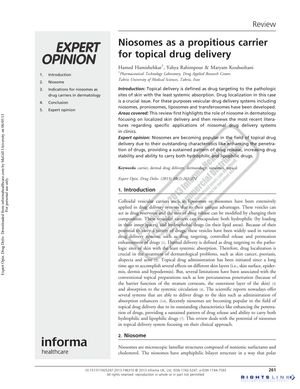TLDR Niosomes are promising for skin drug delivery, offering benefits like improved drug penetration and stability.
The document reviewed the use of niosomes as carriers for topical drug delivery, emphasizing their advantages such as biocompatibility, ability to carry large amounts of drugs, and chemical stability. Niosomes, composed of nonionic surfactants and cholesterol, can encapsulate both hydrophilic and hydrophobic drugs, enhancing penetration and providing sustained release. They have been shown to be effective in treating skin conditions like psoriasis, vitiligo, and hyperpigmentation, and in delivering vaccines and anti-inflammatory agents. For instance, a study with psoriasis patients demonstrated a threefold reduction in PASI scores after 12 weeks of using niosomal methotrexate gel. In the context of alopecia, a study with 20 human volunteers showed that niosomal formulations containing Thai Lanna plant extracts significantly increased hair density and decreased hair loss. Niosomes also showed potential in acne treatment and were found to be more stable and cost-effective than liposomes. Despite their promise, further clinical studies are needed to confirm their efficacy, and the selection of suitable surfactants is crucial for optimal application and toxicity profiles.
 21 citations
,
April 2012 in “European Journal of Pharmaceutics and Biopharmaceutics”
21 citations
,
April 2012 in “European Journal of Pharmaceutics and Biopharmaceutics” The gel with special fat-loaded particles from rice bran could be an effective skin treatment for hair loss.
 111 citations
,
March 2012 in “Expert Opinion on Drug Delivery”
111 citations
,
March 2012 in “Expert Opinion on Drug Delivery” Liposomes could improve how skin care products work but are costly and not very stable.
 22 citations
,
August 2011 in “Journal of Supercritical Fluids”
22 citations
,
August 2011 in “Journal of Supercritical Fluids” Rice bran extract might help prevent hair loss.
 24 citations
,
November 2009 in “Pharmaceutical Development and Technology”
24 citations
,
November 2009 in “Pharmaceutical Development and Technology” Transcutol P best increases Finasteride absorption for hair loss treatment.
 268 citations
,
April 2009 in “International Journal of Pharmaceutics”
268 citations
,
April 2009 in “International Journal of Pharmaceutics” Niosomes improve minoxidil skin delivery for hair loss treatment.
 85 citations
,
January 2007 in “Journal of Drug Targeting”
85 citations
,
January 2007 in “Journal of Drug Targeting” Liposomes better deliver minoxidil for hair loss treatment than niosomes.
 127 citations
,
June 2006 in “International Journal of Pharmaceutics”
127 citations
,
June 2006 in “International Journal of Pharmaceutics” Liposomes and niosomes improve finasteride delivery for hair loss treatment.
161 citations
,
April 2006 in “Journal of Investigative Dermatology” Liposomes with certain properties can effectively deliver drugs deep into hair follicles.
205 citations
,
January 2005 in “Skin pharmacology and physiology” Liposomes and niosomes can help drugs penetrate the skin better.
 397 citations
,
February 2004 in “British Journal of Dermatology”
397 citations
,
February 2004 in “British Journal of Dermatology” Minoxidil boosts hair growth by opening potassium channels and increasing cell activity.
 15 citations
,
October 2012 in “InTech eBooks”
15 citations
,
October 2012 in “InTech eBooks” Niosomes are a promising and effective way to deliver drugs through the skin.
 130 citations
,
August 2020 in “Drug Design Development and Therapy”
130 citations
,
August 2020 in “Drug Design Development and Therapy” Nanoparticles can improve skin drug delivery but have challenges like toxicity and stability that need more research.
 48 citations
,
December 2013 in “Drug Delivery and Translational Research”
48 citations
,
December 2013 in “Drug Delivery and Translational Research” Niosomes improve minoxidil skin penetration for hair loss treatment.
 268 citations
,
April 2009 in “International Journal of Pharmaceutics”
268 citations
,
April 2009 in “International Journal of Pharmaceutics” Niosomes improve minoxidil skin delivery for hair loss treatment.
42 citations
,
November 2022 in “Cosmetics” Niosomes improve the effectiveness of skin and hair cosmetics.











